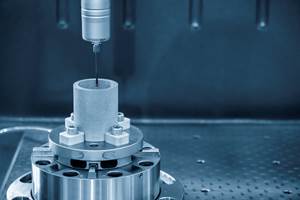The Real Dirt About Gaging
I'm not sure that any of us in the metrology business are very close to godliness, but I do know that cleanliness is the first step to approaching accuracy in gaging. Probably every machinist is at least nominally aware that dirt can interfere with the ability to take accurate measurements.
Share





I'm not sure that any of us in the metrology business are very close to godliness, but I do know that cleanliness is the first step to approaching accuracy in gaging. Probably every machinist is at least nominally aware that dirt can interfere with the ability to take accurate measurements. But the importance of the issue cannot be over-emphasized, and even a conscientious user occasionally needs a reminder.
Here's a quick reality check: Leave your gage out of its box for a few hours. Then check it for zero setting. Next, clean the measuring surfaces, blow off the lint, and check the zero setting again. You will probably find a difference of about 0.0005 inch due to dirt on these surfaces.
We left a clean master disc, marked 0.7985 inch XX, unprotected for a number of hours on a workbench in the shop. Then, taking special pains not to touch its measuring surfaces, we brought it into a temperature controlled room and let it cool off before measuring it with an electronic comparator. The needle went off the scale, which meant that the master plus dirt was more than 0.0003 inch larger than the nominal 0.7985 inch setting. Then we carefully and thoroughly cleaned the master with solvent and measured it again. The reading was +0.000004 inch from nominal.
Finally, we cleaned the master again, using the time-honored machinist's method of wiping it with the palm of the hand. Measuring again, it had gone up to +0.000013 inch. We lost half the normal gage tolerance by "cleaning" it with the palm. (Some slight error may also have been introduced through expansion of the master due to conductive heating from the hand. More on this subject in a later column.)
We have already seen how dirt in invisible quantities can skew a measurement, both on the contacting surfaces of the gage itself and on the workpiece or master. And recall that our examples were reasonably clean environments. Now picture the common abode of a gage in your shop: Is it living in an oil-and-chip-filled apron of a lathe or screw machine, or perhaps sharing the pocket of a shop apron with pencil stubs, pocket lint and what-have-you?
Aside from simply getting in the way of a measurement, dirt also impedes accurate measurement by increasing friction in a gage's movement. Drag may prevent a mechanism from returning to zero, and every place that friction must be overcome represents a potential for deflection in the gage or the setup. If dirt is the biggest enemy of accurate measurement, then friction is a close second.
The next time you have a service technician in the shop to work on a gage, watch this person carefully. Chances are, the first step is to clean the gage, whether it is a simple dial indicator or a coordinate measuring machine. If you take away only one thing from this column, this should be it: Eliminate dirt as a possible source of error before attempting to diagnose a malfunctioning gage.
Related Content
How to Evaluate Measurement Uncertainty
Manufacturing and measurement are closely coupled. An important consideration for the use of measurement results is the associated measurement uncertainty. This article describes common metrology terms and provides an example uncertainty analysis.
Read MoreOrthopedic Event Discusses Manufacturing Strategies
At the seminar, representatives from multiple companies discussed strategies for making orthopedic devices accurately and efficiently.
Read MoreHow to Choose the Correct Fixed-Body Plug Gaging Solution
The two types of fixed-body plug gages are both accurate, fast and easy to use. Consider these factors when selecting one for your gaging application.
Read MoreParts and Programs: Setup for Success
Tips for program and work setups that can simplify adjustments and troubleshooting.
Read MoreRead Next
Last Chance! 2025 Top Shops Benchmarking Survey Still Open Through April 30
Don’t miss out! 91ÊÓƵÍøÕ¾ÎÛ's Top Shops Benchmarking Survey is still open — but not for long. This is your last chance to a receive free, customized benchmarking report that includes actionable feedback across several shopfloor and business metrics.
Read MoreMachine Shop MBA
Making Chips and 91ÊÓƵÍøÕ¾ÎÛ are teaming up for a new podcast series called Machine Shop MBA—designed to help manufacturers measure their success against the industry’s best. Through the lens of the Top Shops benchmarking program, the series explores the KPIs that set high-performing shops apart, from machine utilization and first-pass yield to employee engagement and revenue per employee.
Read MoreAMRs Are Moving Into Manufacturing: 4 Considerations for Implementation
AMRs can provide a flexible, easy-to-use automation platform so long as manufacturers choose a suitable task and prepare their facilities.
Read More




















